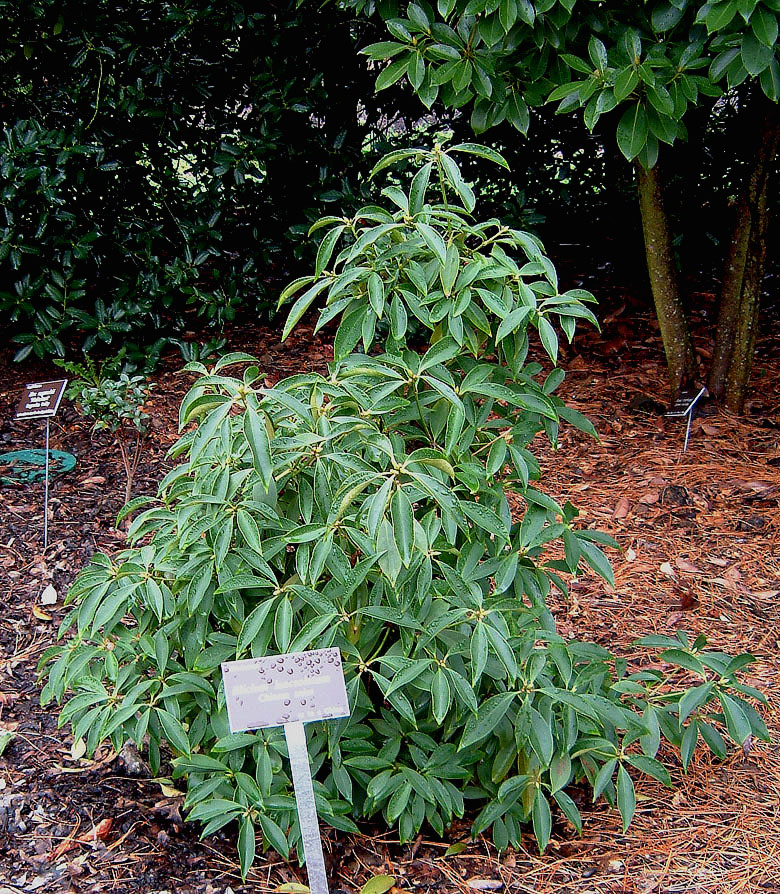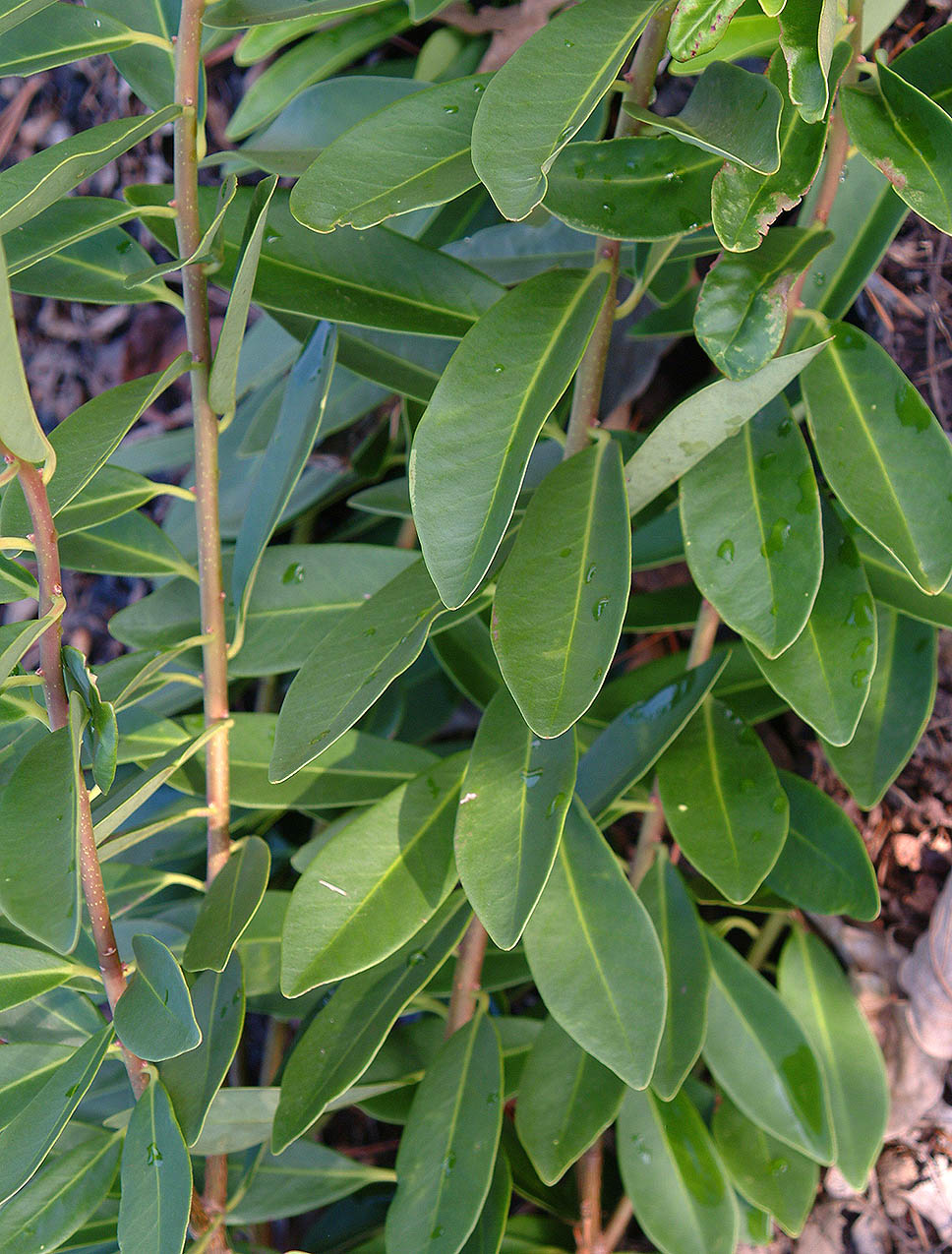 'Album' - click
image to enlarge
'Album' - click
image to enlargeWhite Garden, Raulston Arboretum. April 2003. If you look close at one of the back-facing flowers this taxon is not entirely free of all red pigments.
| NOS ILLICIUM PAGE |
| Copyright
2000-2004. New Ornamentals Society. All Rights
Reserved. Lawful for online access only by current society members. All downloading, printing, saving to media, or offline use is prohibited. Do not link to this page. |
Illicium
anisatum 'Pink Stars'
fc: pink in bud fading to near white.
lc: bright crimson red becoming typical green
or: NCSU Arboretum and admired by M. Dirr
in: NCSU Arboretum to NC trade c. 1992
li: Raulston, J.C. 1992. An overview of anise trees. NCSU Arb.
News. 23: 9
 'Album' - click
image to enlarge
'Album' - click
image to enlarge
White
Garden, Raulston Arboretum. April 2003. If you look close at one
of the back-facing flowers this taxon is not entirely free of all
red pigments.
Illicium
floridanum 'Album' ('Alba', f. album, f. alba)
ha: Dirr reports the clone he has is more compact than species
typical.
fc: white or nearly white, sometimes cream when young.
lc: lighter green than species typical
ns: intermediate to pink colors occur in the wild
or: They occur in the wild and perhaps f. album would be a better
rank. Publication of that rank is
or: not in the literature to our knowledge.
Illicium
floridanum Compact Group
ha: more compact, dense, and often more spreading than species
typical
Illicium
floridanum 'Coosa Red' (4/00)
ha: compact
fc: red
or: selected in central AL woods by Mail-Order Natives
so:
Mail-Order Natives
Illicium
floridanum [cream centered]
lc: cream center with irregular green margins
lsp: Dirr reports this variant in his garden (1998)
li: Dirr, M.A. 1998. Man. Woody Land. Plts. Stipes. p. 490
Illicium
floridanum 'Halley's Comet'
ha: more vigorous than some species selections, a good performing
in nursery production
fc: darker red
ft: petals slight reflexed
fq: more floriferous than species typical
bt: longer bloom period than species typical
or: John Allen Smith, Magnolia Nursery, Chunchula AL USA found
near De Funiak Springs FL
Illicium
floridanum 'Hoffman'
fc: typical dark red
fd: larger
fq: more numerous - sparseness of bloom is a species flaw
or: found in Abbeville AL around 1938
rd: 1955 by J.I. Hoffman of Forsyth GA
li: HortScience 21(3): 363 (1986)
Illicium
floridanum Compact Group 'Pebblebrook'
ha: more compact, dense
or: Dr. John Ruter found in S. GA USA
li: Dirr, M.A. 1998. Man. Woody Land. Plts. Stipes. p. 490
 'Head-Lee
Compact' - click image
'Head-Lee
Compact' - click image
Illicium
floridanum Compact Group 'Head-Lee Compact'
ha: more compact, dense
in: Head-Lee Nursery SC USA
li: Dirr, M.A. 1998. Man. Woody Land. Plts. Stipes. p. 490
Illicium
floridanum Pink Group NEW CULTIVAR GROUP ('Pink', 'Pink Form')
fc: various shades of light to medium pink, intermediate between
the species and 'Album'
or: this pink variants occur in the wild and several are in
cultivation in the US. Dirr reports one variant
or: collected by Chuck Salter in 1987. We presume this is the
same as 'Salter Pink' (see below)
in: Woodlanders Nursery SC USA c. 1980's
Illicium
floridanum 'Jo's Variegated'
lc: new growth dark green with light creamy-green or chartreuse
margins at 50-70% of surface.
lt: slightly puckered
lw: narrower than species typical
fc: white tinged pink
or: Jo Levy, Memphis TN as sport of 'Album'
li: Dirr, M.A. 1998. Man. Woody Land. Plts. Stipes. p. 490
Illicium
floridanum Pink Group 'Salter Pink' (4/00)
fc: dark pink
or: selected in FL panhandle by Mail-Order Natives
so:
Mail-Order Natives
Illicium
floridanum 'Salter White' (4/00)
fc: pure white
or: selected in FL panhandle by Mail-Order Natives
so:
Mail-Order Natives
Illicium
floridanum 'Semmes'
ha:
smaller than species typical
fc: white
fq: more floriferous than some 'Album', being a better named
clones
or: Tom Dodd Nurseries from Semmes AL area
Illicium
floridanum Pink Group 'Shady Lady' ('Thayer')
fc: pink
lc: gray-green with grayish white margins
or: Tom Dodd as sport of 'Semmes'. Thayer is his wife.
ns: Dirr says 'Thayer' may prove to be the correct, earlier name.
li: Dirr, M.A. 1998. Man. Woody Land. Plts. Stipes. p. 492
Illicium
floridanum [Woodlander's variegate]
lc: irregularly streaked and mottled creamy white
in: Woodlanders Nursery SC USA
li: Dirr, M.A. 1998. Man. Woody Land. Plts. Stipes. p. 492
 Illicium
henryi - click image
Illicium
henryi - click image
Raulston Arboretum. Summer 2003. This
species is sometimes offered but remains rare.As it can reach 12-14 feet tall it
is not as popular as the smaller sorts. The quality of the leaf is remarkable
and very different among the familiar set of broadleaf evergreens for USDA zones
7-10. It has a "half whorl" of foliage that is more likely to be charming than
the other species. The pink to red flowers are standard high interest as others
in the genus.
Illicium henryi
 Illicium
lanceolatum - click image
Illicium
lanceolatum - click image
Illicium lancefolium is an interesting rare species which
seems very acceptable just for the foliage alone. It has
I. anisatum, I. parviflorum, and I. floridanum beat for
one thing. Stayed tune for flower information and images. I'll guess a
cultivar or two of it is named in the next decade or so. It is certainly
worthwhile to add to any breeding program. Summer 2002.
Illicium lanceolatum
Illicium
mexicana 'Aztec Fire'
ha: vigorous
fc: red
fd: larger than species typical - quite a bit more showy as a
result
bt: may rebloom
or: Yucca Do Nur. of Waller TX as a superior seedling found in
Mexico.
in: Yucca Do Nur. to TX trade, JC Raulston to NC trade and other
collections
photo, description:
JC Raulston Arboretum
 'Forest Green'
- click image
'Forest Green'
- click image
Raulston Arboretum. Fall
2003. If you know this species with its excessively pale, bland leaf this clone
will immediately stand out. But is that color contrast something we want to give
up? You decide. I for one like it as so much else is darker yet. LCH.
Illicium
parviflorum 'Forest Green'
ha: more compact than species typical
lc: darker, more glossy green than species typical - the light
green of the species is useful for
lc: contrast with other shrubs so this selection is perhaps less
rewarding than one might wish.
ls: more rounded than species typical
li: Dirr, M.A. 1998. Man. Woody Land. Plts. Stipes. p. 493
Illicium
parviflorum 'Jekyll'
lc: darker green than species typical. Dirr states it has not
always held up this distinct trait in production.
or: found in a hedge row due to its distinctly darker color,
presumably by Dr. Dirr (?)
photo, web:
Nobleplants.com (online website 2001)
Illicium
religiosum [white margined]
lc: margined white, rather uniformly so, about 15-20% of surface/
li: Yokoi, M. and Y. Hirose. 1978. Variegated Plants. Siebundo
Shinkosha Pub. Ltd.
Illicium
religiosum [yellow-green centered]
lc: irregularly centered yellow-green, 50-70% of surface, rather
subtle.
li: Yokoi, M. and Y. Hirose. 1978. Variegated Plants. Siebundo
Shinkosha Pub. Ltd.
Illicium
religiosum [yellow mottled, margined]
lc: margined and mottled yellow, some blades up to 75% of
surface. Reminds one of Euonymus japonicus.
li: Yokoi, M. and Y. Hirose. 1978. Variegated Plants. Siebundo
Shinkosha Pub. Ltd.
Illicium
religiosum [yellow splashed]
lc: splashed yellow, often subtle, midrib often yellow.
li: Yokoi, M. and Y. Hirose. 1978. Variegated Plants. Siebundo
Shinkosha Pub. Ltd.
Illicium 'Woodland Ruby' is a remarkable cherry red contrast with the freshest green. It is a hybrid of the I. mexicanum with the American I. floridanum. It gains flower size from the Mexican species and perhaps more cold hardiness from the American one. It seems to be more vigorous and strong than either of the two species or at least most of their clones sold now.
If you look close to the flowers in this image, you'll notice it being more ruby red on the margins and quite pinkish in the center back of each petal. In this respect, some other selections prove darker red overall. But the brightness here combined with the very large blooms to 1.5 in. wide are remarkable.
There is hardly a better representative of this fine genus around. The hardiness of USDA 6-7 limit it from being an absolute bombshell in all of the eastern US nursery trade. LCH
Illicium
'Woodland Ruby' (I. mexicanum x I. floridanum)
fc: bright, medium red, dark ruby red on the petals margins and
paler to pinkish on the center backs.
fd: 1.5 in. - larger than most I. floridanum
eval: it is probably the best of the red-flowered cultivars today
(2003) due to the large and colorful blooms
eval: combined with excellent vigor and glossy foliage.
ch: 6-7 - one parent is hardy to 7, the other to 6.